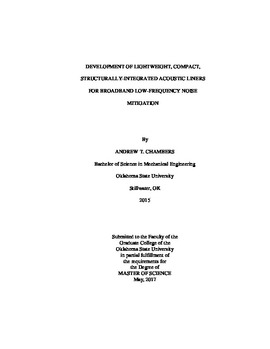| dc.contributor.advisor | Manimala, James M. | |
| dc.contributor.author | Chambers, Andrew Thomas | |
| dc.date.accessioned | 2018-03-13T18:15:08Z | |
| dc.date.available | 2018-03-13T18:15:08Z | |
| dc.date.issued | 2017-05-01 | |
| dc.identifier.uri | https://hdl.handle.net/11244/54500 | |
| dc.description.abstract | Airborne noise with a low dominant frequency content (<~500 Hz) has detrimental effects in many applications, but is as yet beyond the scope of conventional acoustic noise mitigation techniques using liners, foams or claddings owing to mass and volume considerations. Its low evanescence contributes significantly to environmental noise pollution, and unwanted structural vibrations causing diminished efficiency, comfort, payload integrity and mission capabilities. An alternative approach using liner configurations with realistic mass and volume constraints having innovative �folded� core geometries is investigated to ascertain its low-frequency noise absorption characteristics. In contrast to mass-driven approaches, the folded core approach relies on tailoring interactions between acoustic resonances to tune the liner�s impedance to suit the dominant low-frequency content of the source. This allows to keep non-structural mass-addition to a minimum, while retaining an overall thickness comparable to conventional liners for these low-frequency liner designs. The relative acoustic performance of various candidate folded core designs is evaluated by means of a new composite metric termed the Low-Frequency Performance (LFP) factor, which is educed from the absorption coefficient spectrum obtained using Zwikker-Kosten Transmission Line (ZKTL) theory-based numerical studies. An LFP-based software tool is developed to determine optimal 3D cavity packing for a prescribed liner volume and target frequency range. ZKTL-based parametric studies on core dimensions and face sheet porosity are utilized for detailed design of test articles. Experimental verification of absorption coefficient spectra conducted using 3D printed test articles in a normal incidence acoustic impedance tube yield good correlation with simulations. More than 100 Hz of continuous bandwidth with an absorption coefficient greater than 0.6 is shown to be possible in the 300 to 400 Hz range with a 38.1-mm (1.5-inch) thick liner. Further, the influence of face sheet type, Mach number, and sound pressure level on the attenuation across folded core liners is evaluated using grazing flow impedance tube tests. Up to 20 dB of attenuation is observed in the targeted frequency range in these tests indicating potential for performance retention in an operational scenario. With current additive and hybrid manufacturing techniques attaining critical commercial maturity, lightweight and compact acoustic liners employing folded cores could provide a promising practical solution to mitigate low-frequency airborne noise, especially in aerospace applications. | |
| dc.format | application/pdf | |
| dc.language | en_US | |
| dc.rights | Copyright is held by the author who has granted the Oklahoma State University Library the non-exclusive right to share this material in its institutional repository. Contact Digital Library Services at lib-dls@okstate.edu or 405-744-9161 for the permission policy on the use, reproduction or distribution of this material. | |
| dc.title | Development of Lightweight, Compact, Structurally-integrated Acoustic Liners for Broadband Low-frequency Noise Mitigation | |
| dc.contributor.committeeMember | Gaeta, Richard J. | |
| dc.contributor.committeeMember | Arena, Andrew S. | |
| osu.filename | Chambers_okstate_0664M_15114.pdf | |
| osu.accesstype | Open Access | |
| dc.description.department | Mechanical & Aerospace Engineering | |
| dc.type.genre | Thesis | |
| dc.type.material | text | |
